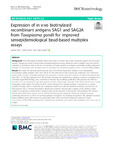2020-10-06Zeitschriftenartikel
Expression of in vivo biotinylated recombinant antigens SAG1 and SAG2A from Toxoplasma gondii for improved seroepidemiological bead-based multiplex assays
Klein, Sandra
Stern, Daniel
Seeber, Frank
Background
Few bead-based multiplex assays have been described that detect antibodies against the protozoan parasite Toxoplasma gondii in large-scale seroepidemiological surveys. Moreover, each multiplex assay has specific variations or limitations, such as the use of truncated or fusion proteins as antigens, potentially masking important epitopes. Consequently, such an assay must be developed by interested groups as none is commercially available.
Results
We report the bacterial expression and use of N-terminal fusion-free, soluble, in vivo biotinylated recombinant surface antigens SAG1 and SAG2A for the detection of anti-T. gondii IgG antibodies. The expression system relies on three compatible plasmids. An expression construct produces a fusion of maltose-binding protein with SAG1 (or SAG2A), separated by a TEV protease cleavage site, followed by a peptide sequence recognized by E. coli biotin ligase BirA (AviTag), and a terminal six histidine tag for affinity purification. TEV protease and BirA are encoded on a second plasmid, and their expression leads to proteolytic cleavage of the fusion protein and a single biotinylated lysine within the AviTag by BirA. Correct folding of the parasite proteins is dependent on proper disulfide bonding, which is facilitated by a sulfhydryl oxidase and a protein disulfide isomerase, encoded on the third plasmid. The C-terminal biotinylation allowed the oriented, reproducible coupling of the purified surface antigens to magnetic Luminex beads, requiring only minute amounts of protein per determination. We showed that an N-terminal fusion partner such as maltose-binding protein negatively influenced antibody binding, confirming that access to SAG1’s N-terminal epitopes is important for antibody recognition. We validated our bead-based multiplex assay with human sera previously tested with commercial diagnostic assays and found concordance of 98–100% regarding both, sensitivity and specificity, even when only biotinylated SAG1 was used as antigen.
Conclusions
Our recombinant in vivo-biotinylated T. gondii antigens offer distinct advantages compared to previously described proteins used in multiplex serological assays for T. gondii. They offer a cheap, specific and sensitive alternative to either parasite lysates or eukaryotic-cell expressed SAG1/SAG2A for BBMA and other formats. The described general expression strategy can also be used for other antigens where oriented immobilization is key for sensitive recognition by antibodies and ligands.
Dateien zu dieser Publikation

